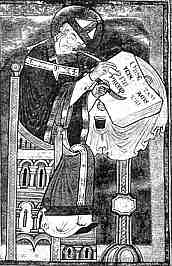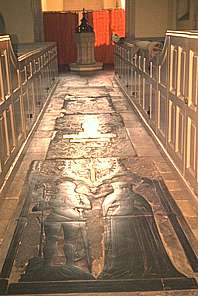




If you are looking at this page without frames, there is more information about medieval writing to be found by going to the home page (framed) or the site map (no frames).
| Works on Science | ||||
| It is a bit of a convention to regard the middle ages as devoid of scientific knowledge, steeped rather in religion and bowed down under the weight of superstition. Like most cliches, this is only very partially true. Today we tend to regard science as a tightly defined discipline of knowledge, with clearly defined rules and conventions for the advancement of that knowledge. But historically, science is neither more nor less than knowledge itself, and they did know stuff in the middle ages. The church did not prevent people from acquiring knowledge, they just had very strong views about using that knowledge to develop inappropriate views. | ||||
 |
We think of science today as involving experiments and observations that are analysed and put into writing. In the medieval era, much written knowledge was progressively compiled from earlier written knowledge and thinking. Knowledge of the natural world was not neatly packaged into disciplinary boxes. Consequently, knowledge which we would classify into various branches of science might appear in different permutations and combinations in various classes of literature. Some of these have already been reviewed on this website. Also, we tend to separate knowledge acquired by scientific method from that derived from written or oral tradition, whether myth, folklore or religion. There was no such division in the medieval era. | |||
| St Dunstan compiling knowledge. | ||||
| The large tomes which are sometimes referred to as medieval encyclopedias, but which are more appropriately termed compendia of knowledge, assembled information about rocks and stars, plants and animals, lands and seas, along with angels, demons and the cosmos. They often started with the seven days of creation and went in all sorts of directions from there. | ||||
 |
||||
| The creation of the world in the windows of York Minster. | ||||
| For more information on this class of books, see the section on Compendia of Knowledge. | ||||
| Subsets of this vast information set were produced as individual volumes. Animals were covered in the volumes known as bestiaries, in which the information was progressively compiled from a miscellany of sources with ever increasing inaccuracy and overlaid with messages of Christian morality. Many of the animals were mythological, and even the real ones were ascribed some very strange habits. The phoenix, as shown on the right, laid down on its funeral pyre and was then reborn into a new life, like Christ. |  |
|||
| From a 12th century bestiary (British Library, Royal 12 c XIV, f.49v). By permission of the British Library. | ||||
| See the section on The Bestiary. | ||||
| Information about plants was collected into herbals. This information was generally compiled from earlier texts, many from ancient Classical sources, so many plants were actually unknown to the medieval scribes who copied and compiled the texts. They included information about the curative properties of plants, thus overlapping with medical literature. Similarly, descriptions of the properties of minerals were compiled into volumes called lapidaries. Nevertheless, there were people who knew how to depict plants realistically from real life, as the sculptors of Southwell Minster have left testimony. Perhaps they were the scientists, and the writers were lost in the clouds of philosophy. | ||||
| Naturalistic carved leaves from column capitals in Southwell Minster. | ||||
| Medical knowledge, as written in medieval manuscripts on the subject, is regarded by us as extremely inaccurate, not to mention dangerous. As with other branches of the sciences, much was recorded through chains of copying, sometimes from way back in the Classical era. Medicine had a distinctly philosophical bent, in the absence of real knowledge about the actual causes of health and disease. Elaborately illustrated manuscripts were produced on the more theoretical aspects of the discipline, while practical remedies and cures were noted in humbler volumes, or even included in commonplace books. | ||||
| See the section on Herbals and Medical Texts. | ||||
| The discipline of astronomy was grounded in what we would consider to be scientific observation, repeated and corroborated over millenia. The regular and repeating patterns of celestial events were noted and computed. Astronomical texts were illustrated with complex diagrams. This does look like science to us, except for one little thing. These observations were also used for the art of astrology, a form of prediction of events that is not based in science as we know it. So it is science and non-science all at once. |  |
|||
| A medieval depiction of the sun and stars, from a 15th century stained glass window in the church of All Saints, North Street, York. | ||||
| See the section on Works on Astrology and Astronomy. | ||||
| The nature of the transformation of materials was something that medieval people had no tools for understanding. Elements and compounds, atoms and molecules were concepts whose time had not yet arrived, and would not for some time. Even by the 18th century there were those who believed that when a substance was burnt it released a substance which they called phlogiston, and the reason that things became heavier when they burnt was because phlogiston had negative mass. This may seem strangely counterintuitive to us with our education grounded in modern science, but the discovery that there was a substance in the air which they called oxygen was a threshold for the whole area of understanding transformation of materials, or the modern science of chemistry. | ||||
| Alchemy, the medieval basis for the process of transformation of materials, was expounded in many manuscripts. While it has been described as a precursor to modern chemistry, like many other branches of medieval knowledge it was grounded in philosophy, belief and written tradition more than empirical modes of enquiry. A brief glance at some bibliographies suggests that the subject really thrived as a written discipline in the 16th and 17th centuries, when you could express some wild and wacky views about the nature of the world without getting excommunicated or worse. | ||||
| A jumping off point for examining alchemy on the web is The Alchemy Web Site which contains a Database of Alchemical Manuscripts as a bibliographical guide. The author clearly feels that the subject is under-investigated. | ||||
| There were medieval people who had practical knowledge about the transformation of materials; metalworkers for example. Every village had a blacksmith or two, which is why Smith is such a common surname in England. These fellows did not just bash hot iron bars into the shape of horseshoes, they actually transformed ores which looked like lumps of rock into metals. Their knowledge of such matters actually made them kind of scary, and blacksmiths are celebrated in song and legend as magicians. In the more esoteric areas of metalworking, there were people who could make large sheets of fine brass as used in funerary monuments like the one at the right, or armourers who could create the highly crafted suits of armour and weapons like those depicted on the tombs. There were bellfounders who could create lumps of metal to strike particular musical notes. They were all practical scientists, but they didn't write books. |  |
|||
| !5th century brass of Sir Simon de Felbrigg and his wife Margaret in the floor of the parish church of Felbrigg in Norfolk. | ||||
| And there were many others. | ||||
|
|
||||
|
If you are looking at this page without frames, there is more information about medieval writing to be found by going to the home page (framed) or the site map (no frames). |
||||